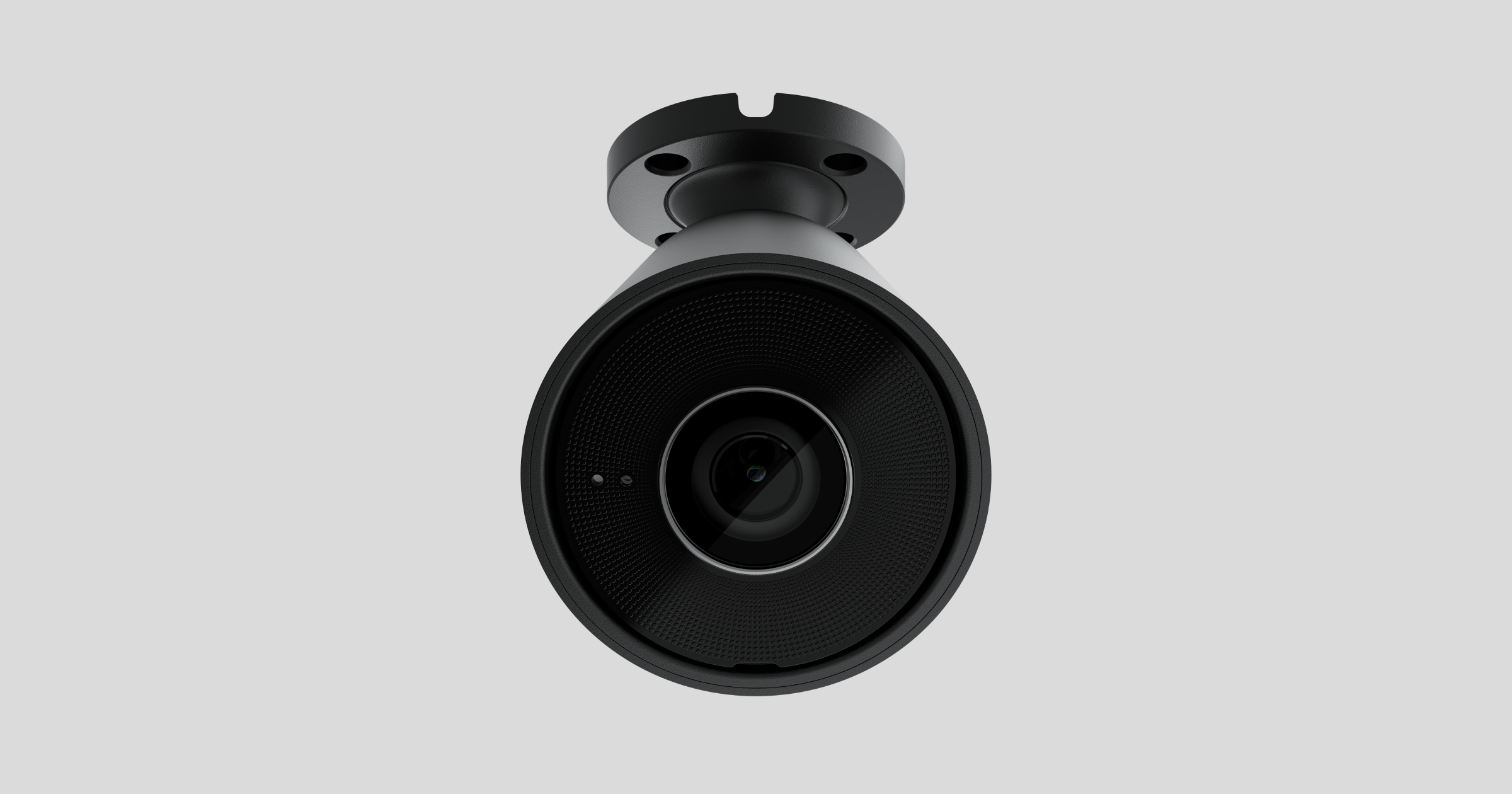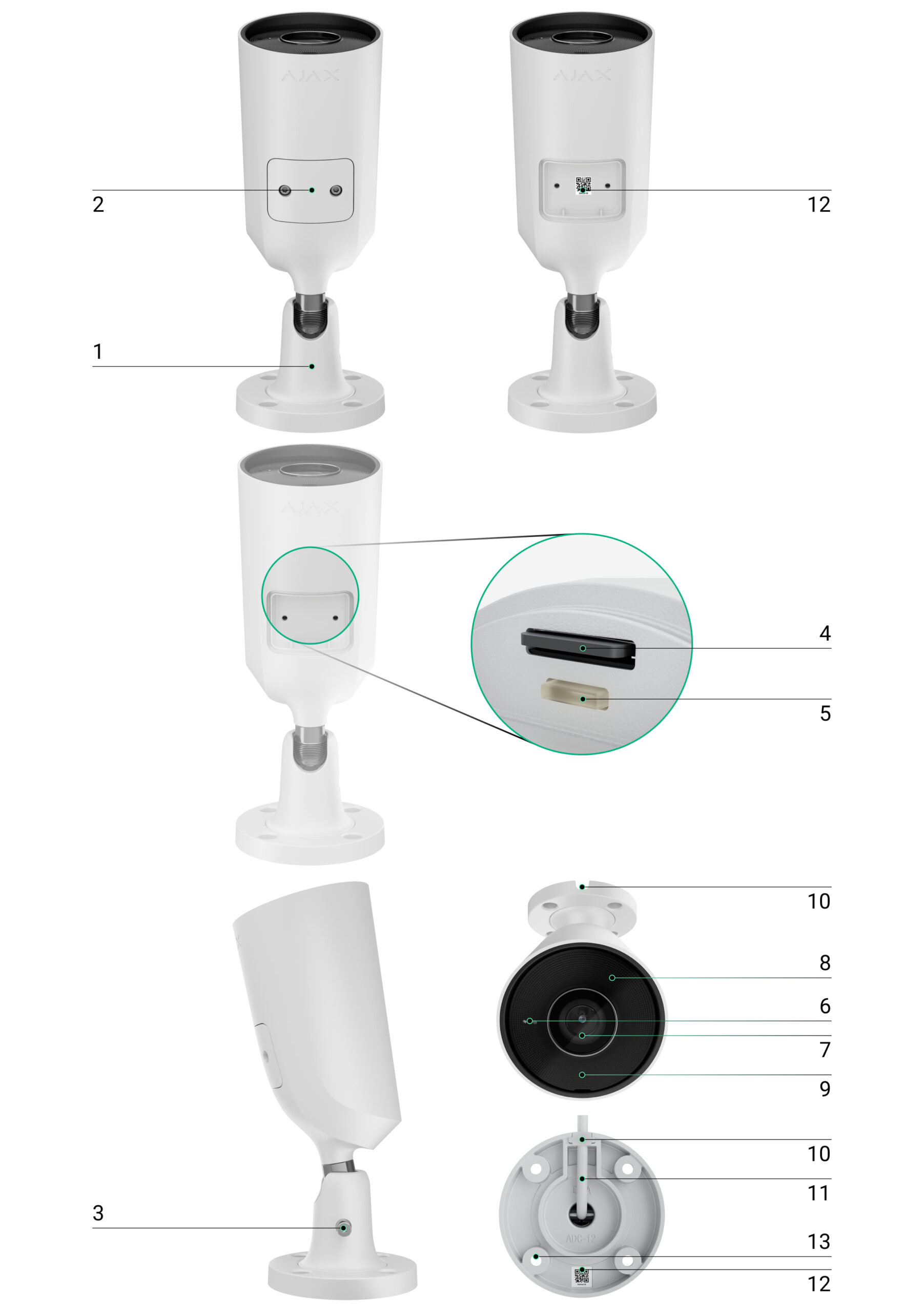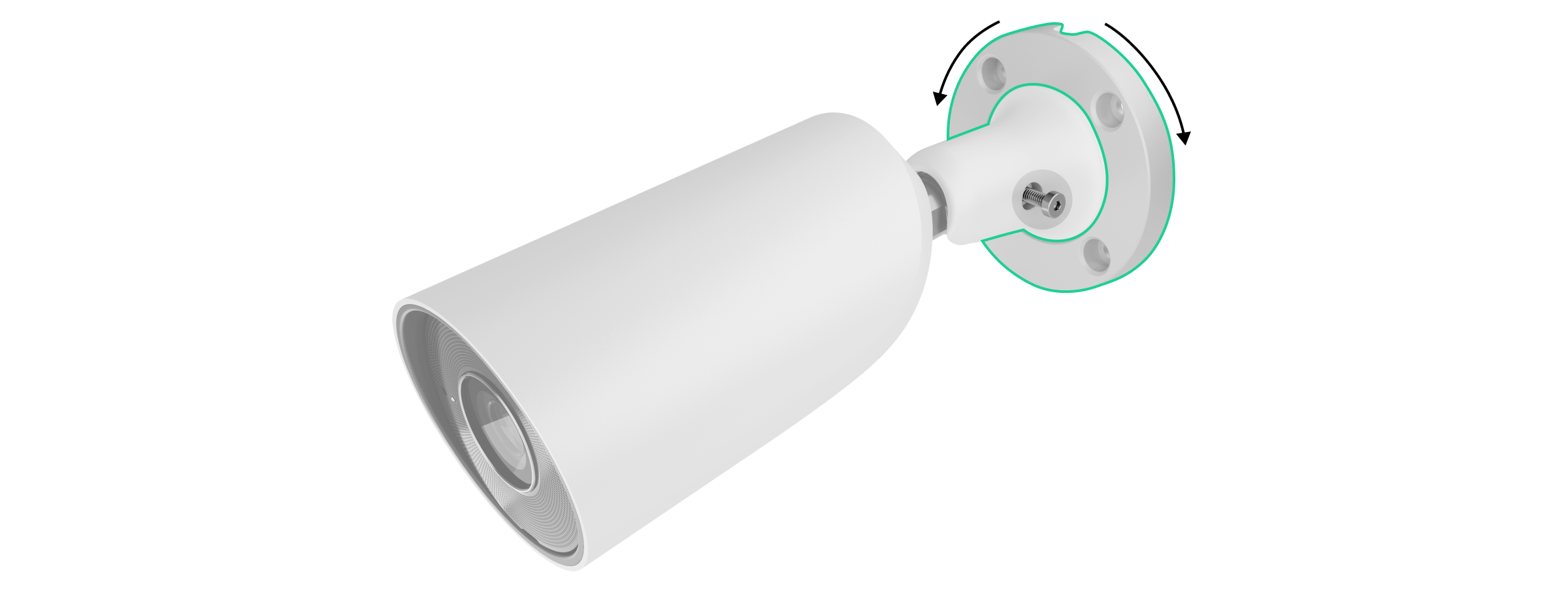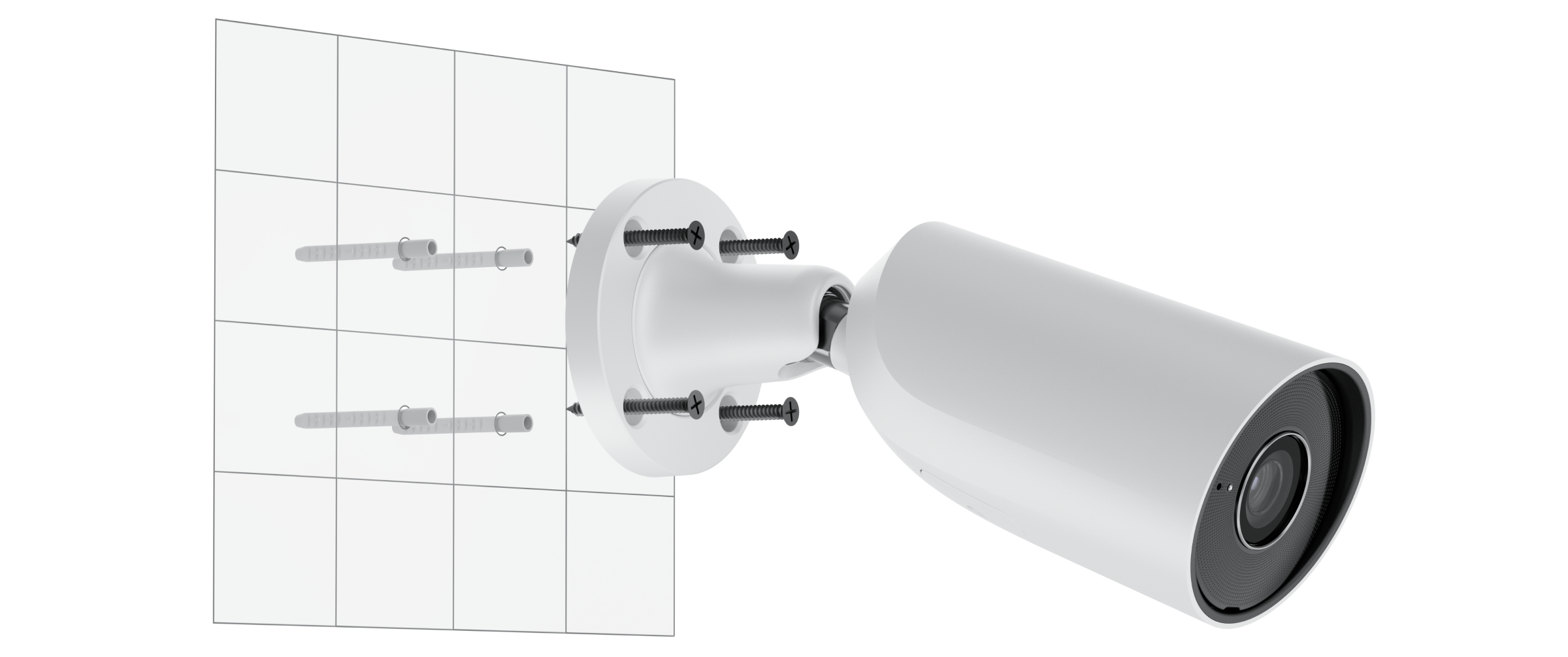BulletCam is an IP camera with a smart infrared (IR) backlight and an object recognition function. The user can view archived and live videos in Ajax apps. To store the captured data, install a microSD card or connect the camera to NVR with an installed hard disk.
The camera is connected to the network via Ethernet, using the appropriate connector.
The camera is available in several versions:
- BulletCam (5 Mp/2.8 mm);
- BulletCam (5 Mp/4 mm);
- BulletCam (8 Mp/2.8 mm);
- BulletCam (8 Mp/4 mm).
Camera versions with other enclosures are also available. All Ajax cameras are available here.
Functional elements
- Swivel mounting bracket.
- Protective cover.
- Screw for fixing camera position.
- Slot for microSD card.
- Reset button.
- Microphone.
- Camera lens.
- Faceted lens. Covers the infrared LEDs and diffuses the rays.
- IR backlight. Used to record videos in dark and low-light conditions.
- Cable channel for routing the cable connector from the camera.
- Cable connector.
- QR code with the device ID. Used to add BulletCam to an Ajax system.
- Holes for attaching the camera to the surface.
Operating principle
BulletCam is an IP camera that uses artificial intelligence (AI) for object recognition. Its algorithms can identify moving objects, distinguishing between humans, animals, or vehicles.
The device features a smart IR backlight, ensuring the capture of high-quality images even in low-light conditions. The camera automatically adjusts the backlight intensity in real time to prevent overexposure, enabling clear visibility of objects that are either far away or too close to the camera in low-light conditions.
BulletCam has an IP65 protection class, making it suitable for outdoor installation. Its robust metal enclosure protects the device against sabotage.
You can install a microSD card with a memory capacity from 32 GB to 256 GB (not included in the complete set of the camera). The memory card should be V30 or faster. Additionally, the device can operate without a memory card or via NVR.
Using the video storage calculator, you can calculate the NVR or camera required storage capacity and estimated recording time based on the video stream settings.
BulletCam enables you to:
- Watch the video in real-time with the ability to zoom in for a closer look.
- Access archived videos, navigating through them based on recording chronology and calendar (this feature is available if a microSD memory card is installed in the camera, or it is connected to NVR with an installed hard disk).
- Configure motion detection zones and the adjust sensitivity level.
- View the Video wall that combines images from all connected cameras.
- Quickly access automation devices control from the cameras’ video player menu.
- Create video scenarios that send a short video from the selected camera to the Ajax app when the security detector is triggered.
- Download the required segments of video recordings from the archive to smartphones or PCs (this feature is available if a microSD memory card is installed in the camera, or it is connected to NVR with an installed hard disk).
The video recording segments downloaded from BulletCam with firmware 2.309 and later have the Ajax digital signature that verifies the integrity of the exported video. To verify the authenticity of the downloaded video recordings, use the Ajax media player software.
- Configure connection via ONVIF to integrate the device with video management systems (VMS) such as Milestone, Genetec, Axxon, and Digifort.
ONVIF authorization is supported by BulletCam with a firmware version 2.356 or later.
An admin or PRO with rights to configure the system can set up a connection via ONVIF in:
- Ajax Security System with the app version 3.25 or later.
- Ajax PRO: Tool for Engineers with the app version 2.25 or later.
- Ajax PRO Desktop with the app version 4.20 or later.
- Ajax Desktop with the app version 4.21 or later.
Video scenarios
The Ajax system offers the capability to use IP cameras for alarm verification. Video scenarios enable the substantiation of alarm triggers with the corresponding video from cameras installed at the facility.
Cameras can be configured to respond to alarms from a single device, multiple devices, or all connected devices. Combined detectors can register various types of alarms, allowing you to configure responses to a wide range of alarm types, whether it’s just one, several, or all of them.
You can also configure the sirens to activate when motion or a specific AI-recognised object is detected. When video devices detect motion or a specific AI-recognised object, the system automatically activates sirens added to the hub to sound an alarm.
Video wall
The user can manage videos on the Video wall tab, accessible once at least one camera has been added. This feature ensures quick access to all connected cameras, displayed in accordance with privacy settings.
In mobile Ajax apps, you can:
- Switch between cameras.
- Search for the desired camera by name.
- Manage a PTZ camera.
In Ajax PRO Desktop, you can:
- Switch between cameras.
- Search for the desired camera by name.
- Organize cameras by room, NVR, or group.
- Manage a PTZ camera.
- Save customized layouts for displaying video from cameras.
- Change the order in which the camera video is displayed.
- Create templates for displaying videos in a slide show.
Privacy zones
The system allows hiding parts of the frame. For instance, if a safe is in view, activity around it can be recorded without revealing its contents by setting up the right zone. No motion or object will be detected and recorded in the privacy zone.
To do this, in Ajax apps:
- Go to the Devices
tab.
- Select the camera from the list. If it is connected to the network video recorder, select NVR and tap on Cameras.
- Go to Settings by tapping on the gear icon
twice.
- Select the Privacy zones menu.
- Go to the Configure privacy zones menu. Select the required area.
- Tap on the
icon. Return to the camera settings.
The user can create up to four private zones.
Selecting the installation site
When choosing the optimal location to install BulletCam, consider the camera’s viewing angle and any potential obstacles that might obstruct its view.
Consider the placement recommendations when designing the security system project for your object. The security system should be designed and installed by professionals. A list of recommended partners is available here.
The camera should not be installed
- Indoors or outdoors where the temperature and humidity levels do not align with the specified operating parameters.
- In locations where objects or structures might obstruct the camera’s view.
- In direct bright light or on bright objects (e.g., a white wall), as it can reduce the image quality. The bright surface reflects the IR backlight and blinds the camera in the dark.
Installation
- Connect the Ethernet cable to the camera. If it is powered by PoE, no external power supply is needed; otherwise, connect both the external power supply and the Ethernet cable.
- Turn on the power supply of the camera. The LED indicator on the cable connector lights up green.
- Add the camera to the system, and disconnect the Ethernet and power supply from the camera.
- Using the bundled hexagon key (Ø 2 mm), remove the screws holding the protective cover. Insert a microSD card (not included) into the appropriate slot. Replace the protective cover and tighten the screws.
After adding BulletCam to the system, format the memory card in the camera settings.
- Using the installation template, mark the locations for the drill holes on the surface where you plan to mount the camera. Secure the template to the chosen installation location with tape, and drill four holes as indicated on the template.
- Loosen the screw on the swivel mounting bracket with the bundled hexagon key (Ø 2 mm) and rotate the bracket if you need to change the cable channel position. Tighten the screw back.
- Route the cable through the cable channel and secure the swivel mounting bracket to the surface using the bundled screws.
- Loosen the screw on the swivel mounting bracket to adjust the camera tilt and rotation position.
- Ensure that the camera lens faces the protected area. Secure it by tightening the screw in the swivel mounting bracket.
- Connect the Ethernet and power supply to the camera. Install a waterproof connector if the camera is used indoors with humidity levels outside the operating parameters, or outdoors.
The recommended electrical parameters for the power supply are 12 V⎓ ± 20% with a current of at least 1 A.
- Turn on the power supply of the camera. The LED indicator on the cable connector lights up green.
Adding to the system
Before adding a device
- Install an Ajax app.
- Log in to your account or create a new one.
- Select a space or create a new one.
- Add at least one virtual room.
- Ensure the space is disarmed.
Only a PRO or a space admin with the rights to configure the system can add the device to the space.
How to add BulletCam
- Open the Ajax app. Select the space to which you want to add the camera.
- Go to the Devices
tab and tap Add device.
- Scan the QR code or enter it manually. Find the QR code on the back of the enclosure and on the packaging.
- Assign a name to the camera.
- Scan the QR code or enter it manually. Find the QR code on the back of the enclosure and on the packaging.
- Select a virtual room and a group (if Group mode is enabled).
- Tap Add device to proceed.
- Ensure the camera is switched on and connected to the internet. The LED indicator should illuminate green.
- Tap Add again.
The connected camera will now appear in the list of devices in the Ajax app.
- Open the Ajax app. Select the space to which you added NVR.
- Go to the Devices
tab.
- Select NVR from the list and tap Cameras.
- Tap Add camera and wait for the network scan to complete and display the available cameras connected to the local network.
Note that the camera must be connected to the same local network as NVR.
- Select the camera.
- Assign a name to the camera, select a virtual room and a group, then tap Finish.
- Wait for the system to add the device, then tap Close.
The newly connected camera will now appear in the list of NVR cameras in the Ajax app.
You can calculate the number of cameras and NVRs that can be added to the space using the video device calculator.
Note that BulletCam is compatible with only one space. To connect the camera to the new space, remove it from the device list of the old one. This removal process needs to be done manually in the Ajax app.
Resetting to the default settings
To reset the camera to the default settings:
- Turn off the camera by disconnecting the external power supply or Ethernet cable (if it is powered by PoE).
- Press and hold the reset button.
- Power the camera while the reset button is pressed, and wait until the button’s LED indicator lights up violet. This will take about 50 seconds.
The button’s LED indicator lights up blue for 20 seconds after powering the camera with a pressed reset button. Then it turns off for 30 seconds and lights up violet. This means that the camera has been restored to the default settings.
- Release the button.
Icons
The icons in the app display some device states. To access them:
- Select a space in the Ajax app.
- Go to the Devices
tab.
- Find BulletCam in the list.
| Icon | Value |
| Live view is available. | |
| Live view is not available. | |
|
Other users have access to view camera video. |
|
| The camera has an archive. | |
| The microSD card is not installed. | |
| The microSD card is installed. | |
| Malfunction of the microSD card is detected. Formatting the microSD card is recommended. | |
| The microSD card is being formatted. | |
| The new firmware version is available. | |
| An error was detected during the firmware update. | |
| The device has lost connection with the Ajax Cloud server. | |
|
The device connection via ONVIF is enabled. |
States
The states display information about the device and its operating parameters. You can find out about the states of the camera in Ajax apps:
- Select a space in the Ajax app.
- Go to the Devices
tab.
- Select BulletCam from the list of devices. If BulletCam is connected to the video recorder, select NVR and then tap Cameras.
| Parameter | Value |
| Malfunction |
Tapping on The field is displayed only if a malfunction is detected. |
| Firmware update | The field is displayed when the firmware update is available:
Tapping on |
| Connection | The camera connection status to the internet via Ethernet:
Tapping the icon |
| Connection to NVR |
Displayed when the camera is connected to NVR. The camera connection status to NVR:
Tapping the icon |
| Storage location | Displays the list of storage devices connected to the camera:
Tapping the icon |
| Memory card | The memory card connection status to the camera:
|
| Resolution | The current camera resolution. |
| Frame rate | The current camera frame rate. |
| Bit rate | The current camera bit rate. |
| Video codec | The current video codec:
|
| Motion detection | The Motion detection function status:
|
| Object detection | The Object detection function settings:
|
| Uptime | The camera’s operating time since the last reboot. |
| Permissions to view (in progress) |
Displays the number of users who have access to view video from the camera. Tapping the icon |
| Firmware | Firmware version of the camera. |
| ID | BulletCam ID/Serial Number. Also available on the QR code on the camera enclosure and its package box. |
Settings
To change camera settings, in an Ajax app:
- Go to the Devices
tab.
- Select BulletCam from the list. If BulletCam is connected to the video recorder, select NVR and tap Cameras.
- Go to Settings by tapping on the gear icon
.
- Set the required parameters.
- Tap Back to save the new settings.
| Settings | Value |
| Name |
Camera name. Displayed in the list of devices, SMS text, and notifications in the events feed. To change the camera name, tap on the text field. The name can contain up to 12 Cyrillic characters or up to 24 Latin characters. |
| Room |
Selection of the camera virtual room. The room name is displayed in SMS text and notifications in the events feed. |
| Arm in Night mode |
When this option is enabled, the camera will switch to the armed mode whenever the system is set to Night mode. |
| Recording preferences | Selection of the Recording mode for each storage device:
Selection of the armed mode when the camera records video:
|
| Notifications from camera detectors |
Opens a menu with Notifications from camera detectors settings. |
| Camera settings | |
| Detection |
Opens a menu with Detection settings. |
| Video stream |
Settings for mainstream and substream parameters. |
| Image |
Settings for camera image quality. |
| On-screen display (OSD) (in progress) | Allows the user to customize the display of additional information on the camera image:
|
| Audio | Settings for audio capture and playback.
|
| Privacy zones | Allows the user to select zones that are not displayed on the camera video. Instead, the user sees a black rectangle. |
| Firmware update | Allows the user to check for a new firmware version and download it. |
| Connection | |
| Connection type |
The setting for selecting the camera’s connection type to Ajax Cloud service via Ethernet. Available connection types:
|
| Memory card |
Selection of the maximum archive depth. It can be set in the range of 1 to 360 days or can be unlimited. Allows the user to format the memory card. |
| Monitoring |
The setting is available in Ajax Pro apps. Allows a PRO with rights to configure the system to set up:
|
| Service |
Opens a menu with Service settings. |
| Report a problem | Allows the user to describe a problem and send a report. |
| User guide | Opens the camera user manual. |
| Unpair from NVR |
Unpairs the device from the NVR to which it was paired. The option is available if the device is paired with NVR. |
| Delete device | Unpairs BulletCam from the space and all NVR where it’s added. |
Notifications from camera detectors
| Settings | Meaning |
| Notify if detected | The user can select the type of object or motion, and when it’s recognized, a notification is received and sirens are activated:
Note that the corresponding types of object or motion should be enabled in the Detection settings. To specify whether motion detection should activate the sirens, tap on the required type of object or motion and enable the Activate sirens upon detection option. The feature is available when the camera and at least one siren are added to an Ajax hub with OS Malevich 2.31 and later versions. |
| When to notify | Selection of the mode when the camera sends notifications:
|
| Interval in reporting similar events |
Selecting the time interval in reporting similar events: from 30 seconds to 8 hours. The default interval is 3 minutes. Selected time applies for each detection type separately and helps to avoid repeated informing of the same triggering reason. |
| Duration of object detection for notification |
Selecting how long an object should remain in the camera’s field of view so the system sends a notification about the detected object. The available values are Notify instantly or 2, 3, 4, or 5 seconds. The default time is 2 seconds. |
Detection settings
| Settings | Meaning |
| Motion detection | When the option is enabled, the camera detects motion using its built-in software. |
| Analyze image |
The software algorithm of image analysis that is used for motion detection. The option is available when Motion detection is enabled. |
| Motion detection settings | Opens a menu with motion detection settings:
The option is available when Motion detection is enabled. |
| Object detection | When the option is enabled, the camera identifies the type of moving objects using a built-in algorithm. In the video, people, pets, and vehicles are highlighted with colored rectangles. |
| Object detection settings | Opens the menu with object detection settings:
The option is available when Object detection is enabled. |
Video stream settings
Settings for mainstream and substream parameters.
| Settings | Value |
| Mainstream | |
| Video codec | Selecting the video compression standard:
|
| Resolution | Selecting the mainstream resolution:
|
| Frame rate | Selecting the frame rate: from 3 to 25 with an increment of 1 frame/s. |
| Bit rate type | Selecting the bit rate type:
|
| Bit rate | Setting the bit rate in kbit/s. |
| GOP length | Selecting the GOP length: from 1 to 250 with an increment of 1 frame. |
| VBR quality/CBR quality | Selecting the compression quality: from 0 to 100 with an increment of 1. |
| Substream | |
| Video codec | Selecting the video compression standard:
|
| Resolution | Selecting the substream resolution:
|
| Frame rate | Selecting the frame rate: from 3 to 25 with an increment of 1 frame/s. |
| Bit rate type | Selecting the bit rate type:
|
| Bit rate | Setting the bit rate in kbit/s. |
| GOP length | Selecting the GOP length: from 1 to 250 with an increment of 1 frame. |
| VBR quality / CBR quality | Selecting the compression quality: from 0 to 100 with an increment of 1. |
Image settings
Settings for camera image quality.
| Settings | Value |
| Brightness | Adjusting the image brightness. |
| Color saturation | Adjusting the image сolor saturation. |
| Sharpness | Adjusting the image sharpness. |
| Contrast | Adjusting the image contrast. |
| Image rotation | Selecting whether to rotate the image:
|
| Wide dynamic range (WDR) |
Enabling or disabling the WDR. When WDR is enabled, it helps to enhance the camera images, with too dark or bright areas. |
| Lighting stabilization | Adjusting the exposure:
This setting is available if Wide dynamic range (WDR) is enabled. |
| Day/Night mode (IR-cut filter) | Selecting the camera vision mode depending on the light conditions:
|
| Lighting threshold for mode switching | Selecting the lighting threshold for switching between the day and night mode:
This setting is available if Day/Night mode (IR-cut filter) is set to Auto. |
| Infrared illumination (IR) | Adjusting the intensity of the IR backlight:
The setting is used for capturing clear images at night or in low light and ensures visibility using IR LEDs when conventional lighting is ineffective. |
| IR intensity |
Adjusting the IR backlight intensity. This setting is available if Infrared illumination (IR) is set to Custom. |
| Set exposure based on | Selecting the frame area on which the exposure is based on:
|
| Exposure mode | Selecting the exposure mode:
|
| Image preferences |
Adjusting the shutter speed for less motion blur or for less noise in the image. This setting is available if Exposure mode is set to Auto. |
| Shutter speed |
Selecting the shutter speed to ensure correct exposure for the image. This setting is available if Exposure mode is set to Manual setup. |
| Exposure compensation | Ability to override automatic exposure settings to manually control the image brightness. |
| Noise reduction | Enabling or disabling the noise reduction. |
| Parameter value |
Adjusting the noise reduction level. This setting is available if Noise reduction is enabled. |
| Anti-flicker (Power frequency) | Selecting the power grid frequency to reduce the image flickering. This setting is used if the camera is capturing the video in low-light conditions and lamps are flickering on the camera image with the power grid frequency. Available parameters:
|
Service settings
| Settings | Meaning |
| Time zone |
Time zone selection. Set by the user and is displayed when viewing video from IP cameras. |
| Connection via ONVIF |
Configuring the device’s connection via ONVIF to third-party VMSs. |
| Server connection | |
| Delay of cloud connection loss alarm, sec |
The delay helps to reduce the risk of a false event about the lost connection with the server. The delay can be set in the range of 30 to 600 seconds. |
| Cloud polling interval, sec |
The frequency of polling the Ajax Cloud server is set in the range of 30 to 300 seconds. The shorter the interval, the faster the cloud connection loss will be detected. |
| Get notified of server connection loss without alarm | When the toggle is enabled, the system notifies users about server connection loss using a standard notification sound instead of a siren alert. |
Indication
The green LED indicator is placed on the cable connector.
| Event | Indication | Note |
| The camera has power. | Lights up green. |
Malfunction
When a BulletCam malfunction is detected, the Ajax app displays a malfunction counter on the device icon. All malfunctions are indicated in the camera States. Fields with malfunctions will be highlighted in red.
A malfunction is displayed if:
- The camera lost connection with the server.
- The camera memory storage device has a malfunction. Press the camera reset button or format the memory storage device in the camera settings.
- Memory storage device needs formatting. Format the memory storage device in the camera settings.
Maintenance
Regularly check the functioning of the camera. If you notice any image degradation, loss of clarity, or darkening, check the camera for dirt. Clean the device’s enclosure to remove dust, cobwebs, and other contaminants as they emerge. Use soft, dry wipes suitable for cleaning electronic equipment.
Avoid using substances that contain alcohol, acetone, petrol, and other aggressive solvents when cleaning the camera. Wipe the lens gently: scratches can result in poor-quality images and camera failure.
Technical specifications
Warranty
Warranty for the Limited Liability Company “Ajax Systems Manufacturing” products is valid for 2 years after the date of purchase.
If you encounter any issues with the device’s functionality, we recommend contacting Ajax Technical Support first. In most cases, technical issues can be resolved remotely.
Contact Technical Support:





